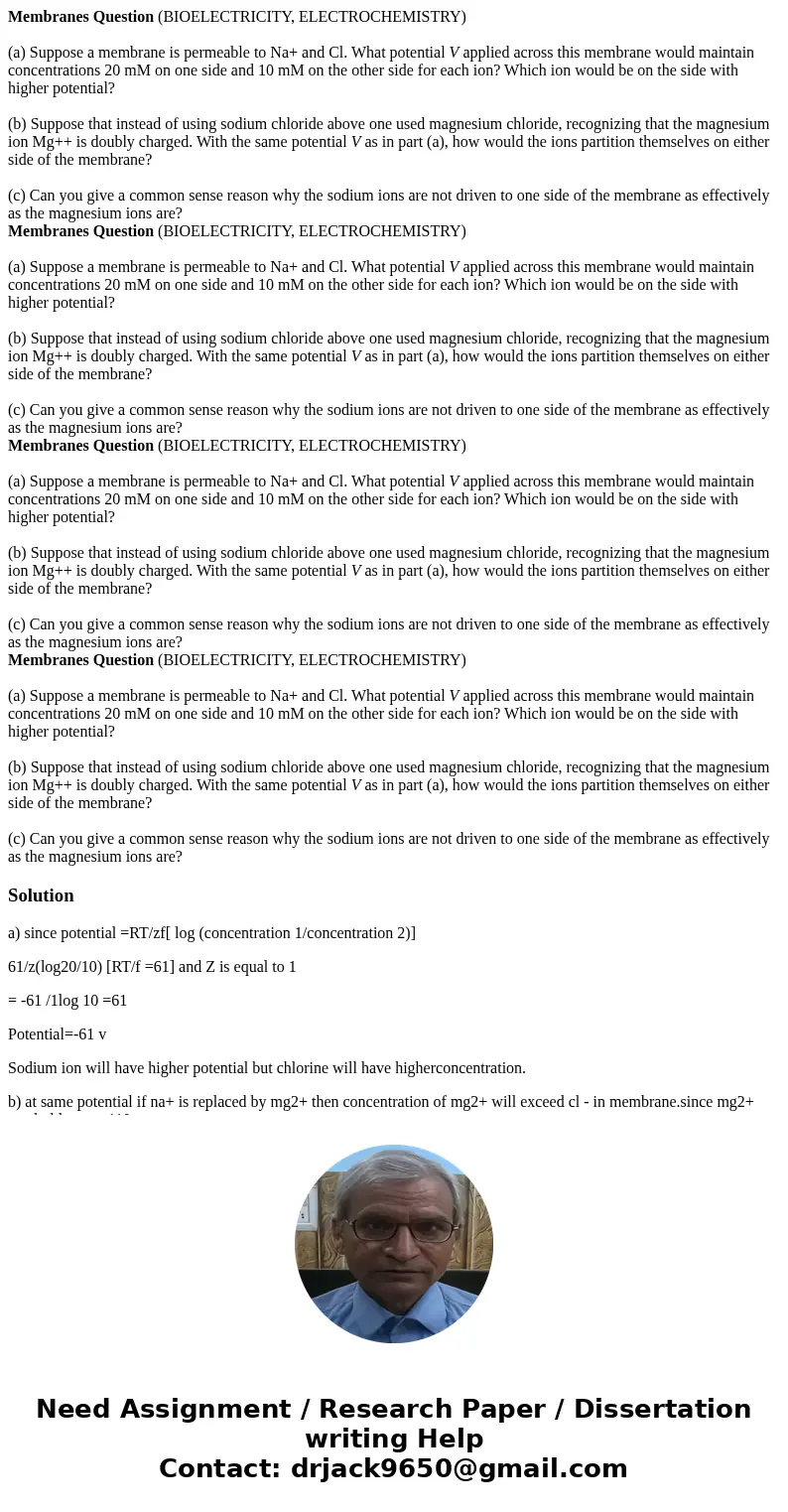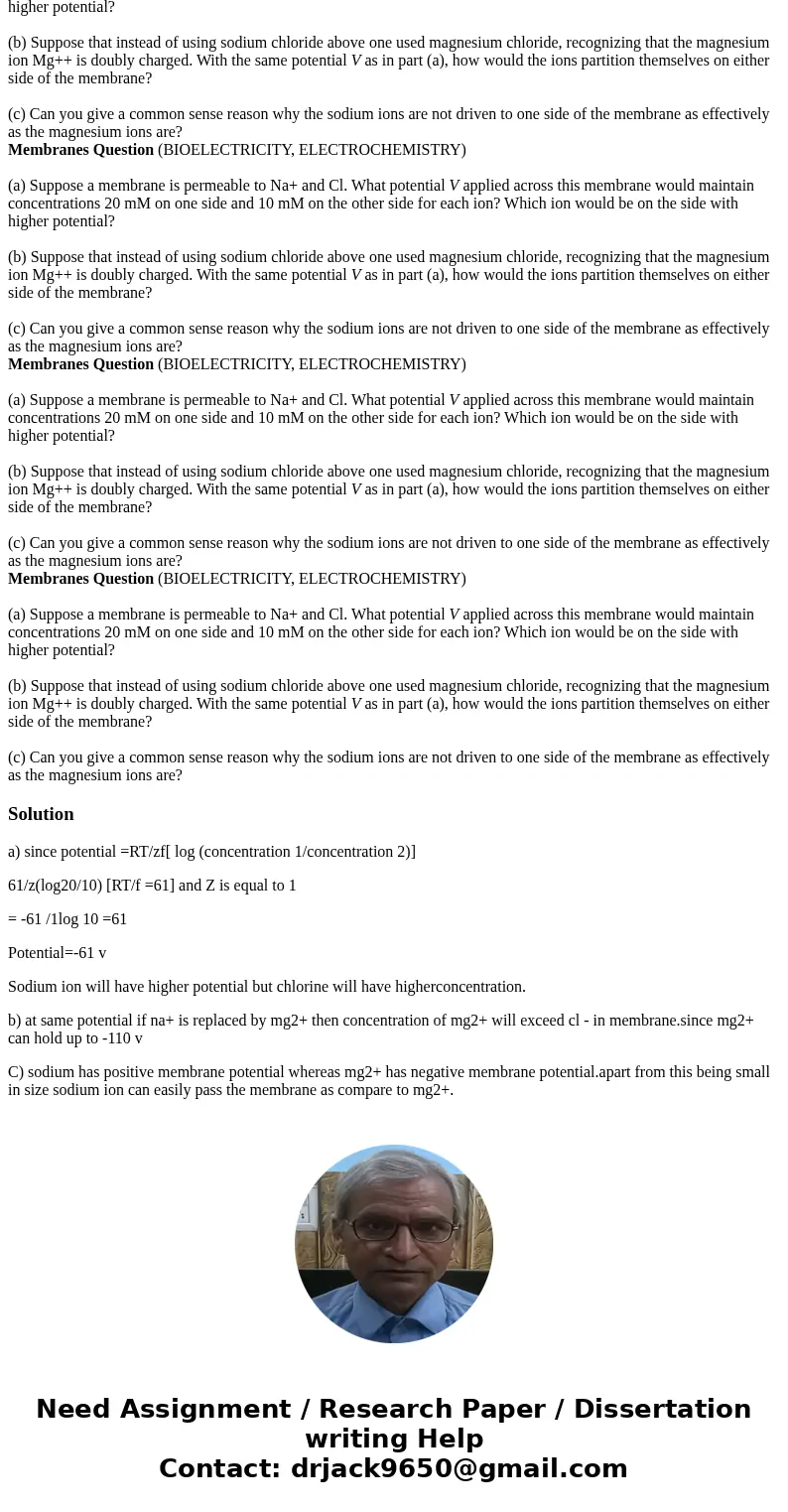Membranes Question BIOELECTRICITY ELECTROCHEMISTRY a Suppose
Membranes Question (BIOELECTRICITY, ELECTROCHEMISTRY)
(a) Suppose a membrane is permeable to Na+ and Cl. What potential V applied across this membrane would maintain concentrations 20 mM on one side and 10 mM on the other side for each ion? Which ion would be on the side with higher potential?
(b) Suppose that instead of using sodium chloride above one used magnesium chloride, recognizing that the magnesium ion Mg++ is doubly charged. With the same potential V as in part (a), how would the ions partition themselves on either side of the membrane?
(c) Can you give a common sense reason why the sodium ions are not driven to one side of the membrane as effectively as the magnesium ions are?
Membranes Question (BIOELECTRICITY, ELECTROCHEMISTRY)
(a) Suppose a membrane is permeable to Na+ and Cl. What potential V applied across this membrane would maintain concentrations 20 mM on one side and 10 mM on the other side for each ion? Which ion would be on the side with higher potential?
(b) Suppose that instead of using sodium chloride above one used magnesium chloride, recognizing that the magnesium ion Mg++ is doubly charged. With the same potential V as in part (a), how would the ions partition themselves on either side of the membrane?
(c) Can you give a common sense reason why the sodium ions are not driven to one side of the membrane as effectively as the magnesium ions are?
Membranes Question (BIOELECTRICITY, ELECTROCHEMISTRY)
(a) Suppose a membrane is permeable to Na+ and Cl. What potential V applied across this membrane would maintain concentrations 20 mM on one side and 10 mM on the other side for each ion? Which ion would be on the side with higher potential?
(b) Suppose that instead of using sodium chloride above one used magnesium chloride, recognizing that the magnesium ion Mg++ is doubly charged. With the same potential V as in part (a), how would the ions partition themselves on either side of the membrane?
(c) Can you give a common sense reason why the sodium ions are not driven to one side of the membrane as effectively as the magnesium ions are?
Membranes Question (BIOELECTRICITY, ELECTROCHEMISTRY)
(a) Suppose a membrane is permeable to Na+ and Cl. What potential V applied across this membrane would maintain concentrations 20 mM on one side and 10 mM on the other side for each ion? Which ion would be on the side with higher potential?
(b) Suppose that instead of using sodium chloride above one used magnesium chloride, recognizing that the magnesium ion Mg++ is doubly charged. With the same potential V as in part (a), how would the ions partition themselves on either side of the membrane?
(c) Can you give a common sense reason why the sodium ions are not driven to one side of the membrane as effectively as the magnesium ions are?
Solution
a) since potential =RT/zf[ log (concentration 1/concentration 2)]
61/z(log20/10) [RT/f =61] and Z is equal to 1
= -61 /1log 10 =61
Potential=-61 v
Sodium ion will have higher potential but chlorine will have higherconcentration.
b) at same potential if na+ is replaced by mg2+ then concentration of mg2+ will exceed cl - in membrane.since mg2+ can hold up to -110 v
C) sodium has positive membrane potential whereas mg2+ has negative membrane potential.apart from this being small in size sodium ion can easily pass the membrane as compare to mg2+.


 Homework Sourse
Homework Sourse